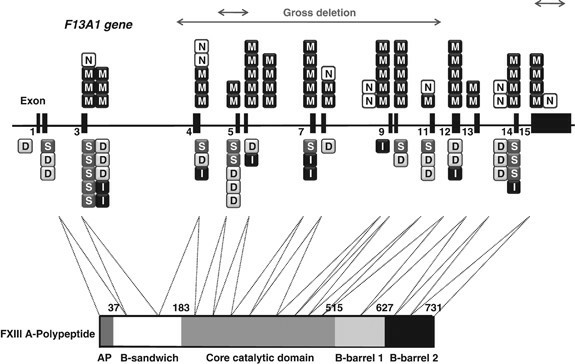What is F13A1 Protein
F13A1, also known as Coagulation Factor XIII A chain, was confirmed in the 1960s when researchers identified a new clotting factor essential for stabilizing the clot by cross-linking fibrin. It became known as Factor XIII and the gene responsible for code encryption, F13A1. This protein belongs to the transglutaminase family, which primarily catalyzes the formation of ε -(γ-Glutamyl)-lysine bonds, making it an essential player in numerous biological processes.
The F13A1 gene is located on chromosome 6 band p24-p25. It consists of 15 exons that encompass about 160 kilobases within the human genome. The protein it encodes, F13A1 or Factor XIII-A, is the catalytic subunit of the proenzyme Factor XIII (FXIII). F13A1 protein is a subunit of tetrameric Factor XIII comprised of two A-subunits and two B-subunits (A2B2). The A-subunits are responsible for enzymatic activity while B-subunits are non-catalytic and protect the A-subunits from proteolysis and control plasma Factor XIII diffusion.

Fig1. Schematic of factor XIII A subunit (FXIII A) gene (F13A1) indicating the location of mutations of congenital FXIII deficiency and FXIII A-polypeptide. (Shinozawa, K. 2011)
Function of F13A1 protein
F13A1's function is incredibly vital in blood coagulation. Its active form, Factor XIIIa, cross-links fibrin chains forming the fibrin clot, ensuring its stability and resistance. Apart from hemostasis, F13A1 is implicated in processes like wound healing, tissue repair, pregnancy, bone metabolism, and protection against bleeding caused by fibrinolysis.
F13A1 protein related signal pathway
The activation of F13A1 protein is tunneled through a signal pathway involving thrombin, a key serine protease. When blood bleeds, thrombin converts soluble fibrinogen into insoluble fibrin strands. These strands then act as a molecular scaffold for F13A1 protein, which in turn strengthens the clot by cross-linking these fibrin strands. An essential calcium-ion-dependent process, this pathway, is crucial for preventing excessive bleeding during wound healing.
F13A1 protein related diseases
However, the malfunction of the F13A1 gene could lead to several health complications. Mutations of the F13A1 gene lead to Factor XIII Deficiency, a rare bleeding disorder characterized by uncontrolled bleeding and a tendency to form inadequate clots. It is an autosomal recessive disorder, which means an individual would require a copy of mutated gene from each parent to have the disease.
Factor XIII deficiency could potentially lead to intracranial hemorrhage and miscarriage in pregnant women due to reduced cross-linking. Among other diseases, a correlation between elevated Factor XIII levels and cardiovascular diseases has been observed. Interestingly, the involvement of F13A1 in wound healing and tissue repair has suggested its potential role in fibrotic diseases.
F13A1 protein's applications in biomedical
In biomedical applications, understanding the F13A1 protein and its functions is paramount. Its central role in wound healing and hemostasis has led to investigations in drug manufacturing. For example, Corifact, an FDA-approved drug for preventing bleeding in people with Factor XIII A-subunit deficiency, is a concentrate of human Factor XIII.
Further, the F13A1 protein expression pattern and its roles in different signal pathways make it a potential biomarker for several diseases. Its elevated levels in cases of inflammation, cancer, and cardiovascular diseases point towards its diagnostic and prognostic utility.
The journey to decipher the comprehensive picture of the F13A1 protein is far from over. In-depth studies directed at understanding F13A1 at genetic, cellular, and molecular levels will pave the way for targeted therapeutics, and hold the key to many potential breakthroughs in the field of medicine.
In conclusion, we're just at the precipice of grasping the potential that lies in understanding this protein. In time, the F13A1 protein might play a critical role in medical diagnostics, pharmaceutical innovations, and treatment strategies. Thus, the little-known F13A1 protein has the capacity to become the major player in various medical revolutions.
Our Featured Products
| Cat.No. | Product Name | Species | Source (Host) | Tag |
|---|---|---|---|---|
| F13A1-3609H | Recombinant Human F13A1 Protein, GST-tagged | Human | Wheat Germ | GST |
| F13A1-125H | Recombinant Human F13A1 Protein, MYC/DDK-tagged | Human | HEK293 | Myc/DDK |
| F13A1-12618H | Recombinant Human F13A1, His-tagged | Human | E.coli | His |
| F13A1-1437HFL | Recombinant Full Length Human F13A1 Protein, C-Flag-tagged | Human | Mammalian cells | Flag |
| F13A1-1332H | Recombinant Human F13A1 Protein, His-tagged | Human | E. coli | His |
| F13A1-881H | Recombinant Human F13A1 Protein, His (Fc)-Avi-tagged | Human | HEK293 | His (Fc)-Avi |
| F13a1-1499M | Recombinant Mouse F13a1 protein, His & T7-tagged | Mouse | E.coli | His/T7 |
| F13a1-1500R | Recombinant Rat F13a1 protein, His & T7-tagged | Rat | E.coli | His/T7 |
Reference
- Shinozawa, K. (2011). Congenital factor XIII deficiency: A commentary on ‘Homozygous intronic mutation leading to inefficient transcription combined with a novel frame-shift mutation in F13A1 gene causes FXIII deficiency'. Journal of Human Genetics, 56(7), 475-476. https://doi.org/10.1038/jhg.2011.53

